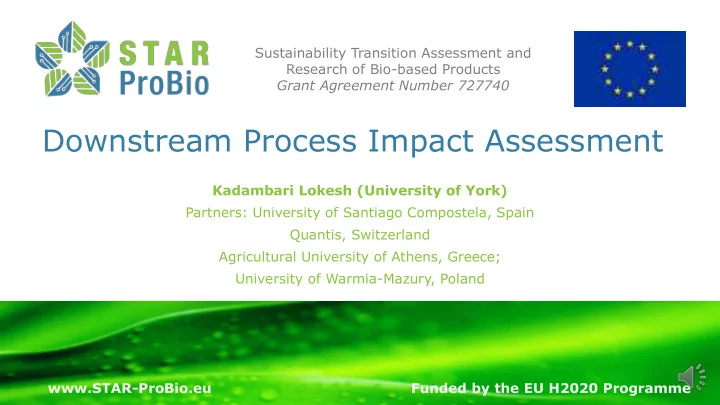

Sustainability Transition Assessment and Research of Bio-based Products Grant Agreement Number 727740 Downstream Process Impact Assessment Kadambari Lokesh (University of York) Partners: University of Santiago Compostela, Spain Quantis, Switzerland Agricultural University of Athens, Greece; University of Warmia-Mazury, Poland www.STAR-ProBio.eu Funded by the EU H2020 Programme
The Aim…. To develop an environmental impact assessment framework for the bio-based products that will feed into the overall (environmental, economic and social impact) assessment blueprint To create a level-playing field for the comparison of bio-based products and their commercially equivalent counterparts; To expand on the existing set of sustainability criteria [beyond those defined in the EN16751]; To evaluate and optimise the expanded criteria, in terms of effectiveness and performance within the overall environmental impact assessment framework. www.STAR-ProBio.eu Funded by the EU H2020 Programme
Environmental Framework Development Methodologies employed for measuring sustainability www.STAR-ProBio.eu Funded by the EU H2020 Programme
Selection of Environmental Indicators From Life Cycle Assessment methodology Based on a previous review of literature (Deliverable 2.1), a selection of LCA indicators that would quantify the sustainability credentials of the bio-based products were identified Impact category Measured as Method employed Global warming potential (Biogenic) kgCO 2 eq PEFCR 6.3 m 3 water deprived equivalents Water scarcity PEFCR 6.3 Particulate matter Disease incidence PEFCR 6.3 UNEP recommended Fossil resource depletion (ADP) MJ CML 2002 (PEFCR 6.3) mol H + eq Acidification PEFCER 6.3; accumulated exceedance mol N - eq and mol P - eq Eutrophication EUTREND in ReCiPe 2008 and (terrestrial and freshwater) Accumulated exceedance Seppäla et al. (2006) Air-quality PM, disease incidence PEFCR 6.3 Human toxicity , cancer CTUh USETOX (PEFCR 6.3) www.STAR-ProBio.eu Funded by the EU H2020 Programme
From Resource Efficiency and Green Chemistry principles Literature review outcomes : 75+ non-LCA indicators were reviewed to identify indicators that could address biomass transformation, energy consumption, water consumption, process auxiliaries usage, hazardous products and waste / avoidance; To create linkages between the resource efficiency characteristics and economic parameters Resource efficiency indicators Measured as Life cycle phase Hazardous Chemical use Qualitative (Red/Green flag) Manufacturing; potentially end-of life Feedstock efficiency kg of feedstock per functional unit Manufacturing; Packaging; Recycling (FU) induced re-use Waste-factor kg of waste per FU All Downstream processes Process material efficiency (also capturing water use % All Downstream processes efficiency) Renewability % Manufacturing Energy Intensity kWh per FU All Downstream processes www.STAR-ProBio.eu Funded by the EU H2020 Programme
From Resource Efficiency and Green Chemistry principles For End of life impact assessment, indicators that address the presence of potentially hazardous substances, secondary material utilisation, waste minimisation, product and process circularity have been presented. Resource efficiency indicators Measured as Life cycle phase Presence of Hazardous chemical Qualitative (Red/Green flag) End-of-life : Recycling and composting EoL Waste factor kg of waste per FU All EoL phases except disposal EoL process material circularity % All EoL phases except disposal EoL Energy Intensity (Material recovery) kWh per FU Mainly for recycling processes EoL Energy Intensity (Incineration with ER) kWh per FU Mainly for incineration with energy recovery EoL Energy Intensity (No material or energy kWh per FU For Incineration without energy recovery) recovery Product circularity Circularity score between ‘0’ and ‘3’ For all EOL phases www.STAR-ProBio.eu Funded by the EU H2020 Programme
Case study application Case studies were selected based on the outcomes of WP1- related activities. This tables summarises the case study characteristics, sources reference flows and functional unit (FU) adopted for applicable methodologies. www.STAR-ProBio.eu Funded by the EU H2020 Programme
Exemplary Case study: Biaxially-oriented Polylactic acid packaging film * Production process only Analysis starts from below the red line www.STAR-ProBio.eu Funded by the EU H2020 Programme
Exemplary Case study: Biaxially-oriented Polylactic acid packaging film *Consumption and End-of-life (EoL) www.STAR-ProBio.eu Funded by the EU H2020 Programme
Exemplary Case study: Biaxially-oriented Polylactic acid packaging film All inputs and outputs associated to the production process accounted for www.STAR-ProBio.eu Funded by the EU H2020 Programme
Reporting the Outcomes – Production process impact assessment for BoPLA Packaging film www.STAR-ProBio.eu Funded by the EU H2020 Programme
Reporting the Outcomes – EoL impact assessment for BoPLA Packaging film BoPLA BoPP Units Life Cycle impact indicators Aerobic composting Disposal onto a landfill per functional unit Global warming potential -4.50 × 10 -3 2.45×10-3 kgCO2eq Respiratory inorganics Deaths 6.33 × 10 -11 1.12 × 10 -3 Human Toxicity, Cancer 6.54 × 10 -12 1.15 × 10 -10 CTU h Acidification, Terrestrial and freshwater 1.39 × 10 -5 9.08 × 10 -6 mol H+ eq Freshwater Eutrophication kg P eq 6.47 × 10 -7 1.36 × 10 -5 m 3 deprived Water scarcity 6.57 × 10 -5 8.65 × 10 -6 Fossil resource depletion 9.80 × 10 -6 2.16 × 10 -2 MJ Units Hybridised Indicators Aerobic composting Disposal onto a landfill per functional unit - Presence of Hazardous Chemicals - - Secondary Resource productivity - kg of feedstock - 4.76 × 10 -3 kg of waste EoL Waste factor 2.65 × 10 -3 EoL Process Material Circularity No data % - % Product circularity 2 0 EoL Energy intensity 2.71 × 10 -4 9.69×10 -4 kWh of energy required Note: FU = Functional unit (1 packaging film that is 350mm × 250 mm with a thickness of 0.05mm) = Non Hazardous chemical present ; = Hazardous chemical present (substitution required) Mass of BoPLA film: 5.58g ; Mass of BoPP film = 4.67g www.STAR-ProBio.eu Funded by the EU H2020 Programme
WP3 Deliverables Environmental impact assessment methodologies, case study application, outcomes and newly recommended sustainability criteria www.STAR-ProBio.eu Funded by the EU H2020 Programme
Acknowledgements Contact ▪ Quantis, Switzerland Kadambari Lokesh ▪ codnoc-starprobio- ▪ Agricultural University of Athens, Greece project@york.ac.uk ▪ University of Santiago Compostela, Spain www.star-probio.eu ▪ University of Warmia-Mazury, Poland This project is funded by the European Union’s Horizon 2020 Research and innovation action under grant agreement No 727740 with the Research Executive Agency (REA) - European Commission. Duration: 36 months (May 2017 – April 2020). Work Programme BB-01-2016: Sustainability schemes for the bio-based economy www.STAR-ProBio.eu Funded by the EU H2020 Programme
Recommend
More recommend